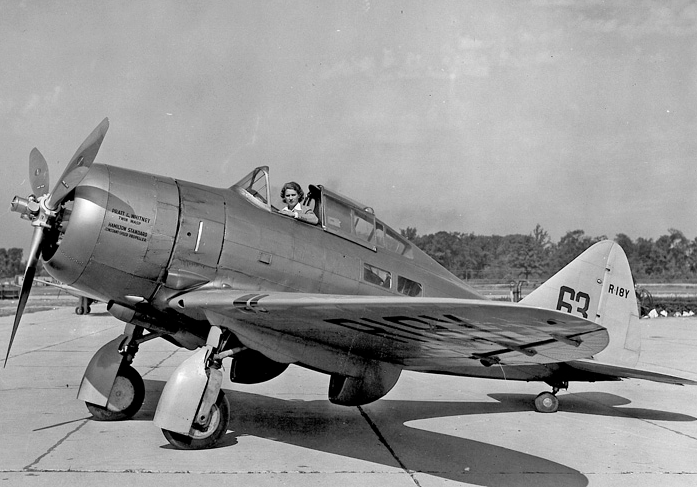

The Lansing, Michigan, State Journal reported:
New York Aviatrix Smashes the Feminine World’s Speed Record at Detroit
BETTERS MARK SET BY FRENCH WOMAN
Jacqueline Cochran Averages Speed of 293.05 M.P.H. In 3-Kilometer Flight
DETROIT, Sept. 21 (AP)—Jacqueline Cochran, New York aviatrix, averaged 293.05 miles an hour in four flights over a three-kilometer course Tuesday, bettering the women’s land plane speed record of 276.527 miles an hour established in 1934 by the late Helene Boucher of France.
Miss Cochran made six flights, three east and three west, over the course, but only four of the flights were included in the official computation. She was timed at 304.62 miles an hour in her fastest dash, an eastward flight. Her speed on the slowest flight was 282.06 miles an hour.
All of the flights were at altitudes of between 100 and 150 feet, thus complying with a National Aeronautics association [sic] rule that flights for records must be made below 250 feet.
Miss Cochran flew a Seversky military pursuit demonstrator, with a 1,200 horsepower engine. The plane is of a type similar to a fleet soon to be put in use at Selfridge field, Mt. Clemens, Mich.
“Ever since I started flying, five years ago, I’ve dreamed of doing this,” Miss Cochran said when she was notified of her record speed.
Her record attempt, made at the Wayne county airport, was postponed four times by adverse winds. She had perfect weather conditions Tuesday.
Airport officials said Miss Cochran’s flights were the fastest ever flown at the airport, by either a man or a woman.
—The State Journal, Vol. 83, Tuesday, 21 September 1937, Page 8, Column 1
For this and her other accomplishments, Ms. Cochran was awarded the Harmon International Aviatrix Trophy by Mrs. Franklin D. Roosevelt in a ceremony in New York City, 4 April 1938.
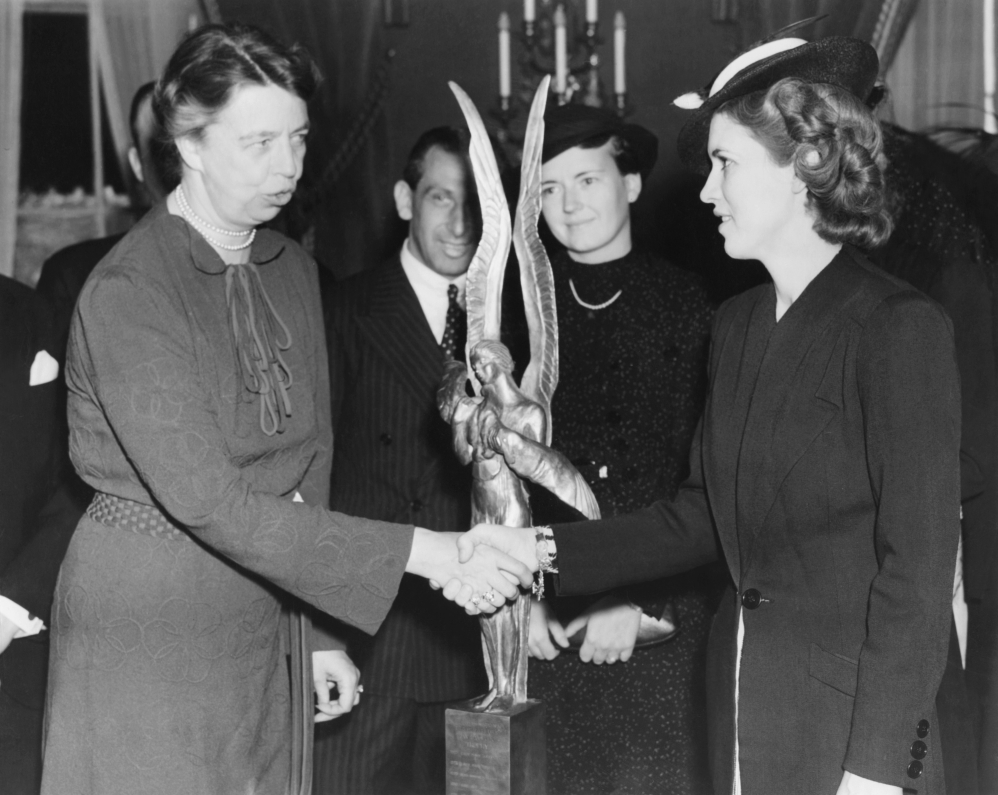
The Seversky SEV-1XP (also called the “SEV-S1 Executive”) was the original prototype for a fly-off against the Curtiss-Wright Model 75 Hawk and Northrop 3A improved version of the P-35 fighter, which was designed by Alexander Kartveli. The P-35 was the first U.S. Army Air Corps single-engine airplane to feature all-metal construction, an enclosed cockpit and retractable landing gear.
The airplane had originally been built as a single-place, open cockpit monoplane with fixed landing gear. It was designated the Seversky II X, s/n 2, and given the experimental registration mark X18Y. In order to compete for the Army Air Corps pursuit contract of 1935, X18Y was modified into a two-place fighter with an enclosed canopy. It was armed with two machine guns mounted in the engine cowling, while a gunner sat behind the pilot with a third machine gun on a flexible mount. Still officially the Seversky II X, the company called it the SEV-2XP.
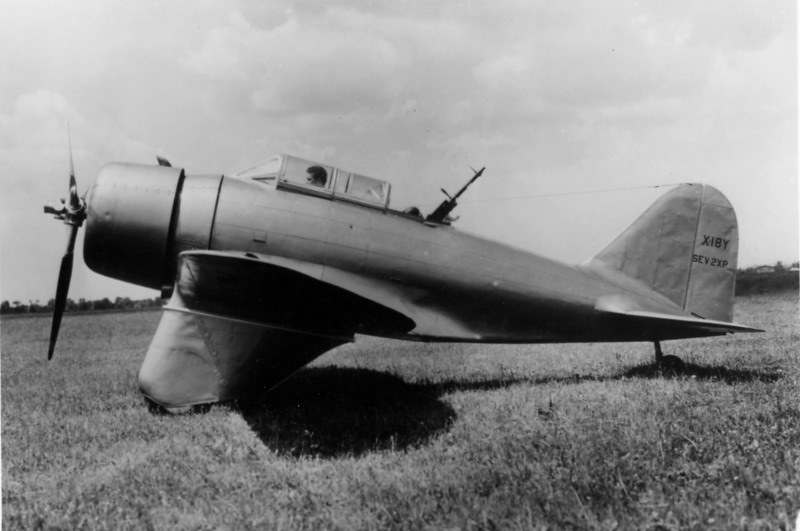
In this configuration, X18Y was powered by an experimental air-cooled, supercharged, Wright Aeronautical Division GR1670A1 Whirlwind. This was a two-row, 14-cylinder radial engine with a displacement of 1,666.860 cubic inches (27.315 liters). It had a compression ratio of 6.75:1 and required 87-octane gasoline. The GR1670A1 had a normal power rating of 775 horsepower at 2,400 r.p.m., and 830 horsepower at 2,400 r.p.m. for takeoff. It drove an experimental three-bladed Hamilton Standard constant-speed propeller through a 16:11 gear reduction. The GR1670A1 was 45 inches (1.143 meters) in diameter, 52-25/32 inches (1.341 meters) long, and weighed 1,160 pounds (526 kilograms).
In mid-May 1935, Major de Seversky flew the prototype from the factory at Farmingdale, New York, toward Wright Field, Dayton, Ohio. The engine overheated, then seized, and Seversky made a forced landing on a small hilltop airfield near St. Clairsville, Ohio. X18Y suffered slight damage. A local pilot flew Seversky on to the meeting at Wright. Once there, he saw the Curtiss-Wright and Northrop competition, both single-place pursuits with retractable landing gear. The SEV-2XP was outclassed.
After repairs, on 20 June Seversky flew X18Y out of the small field and returned it to Farmingdale. It was extensively reconfigured as a single-place airplane. A new wing with retractable landing gear was installed, as were new tail surfaces. A Wright Cyclone R-1820G4 9-cylinder radial engine replaced the experimental GR1670A1. The G4 had a normal power rating of 810 horsepower at 2,100 r.p.m., and 1,000 horsepower at 2,200 r.p.m., using 87-octane gasoline. Seversky redesignated X18Y as the SEV-1XP. After a fly off with the modified prototype, the Air Corps placed an order for 100 Seversky P-35s.
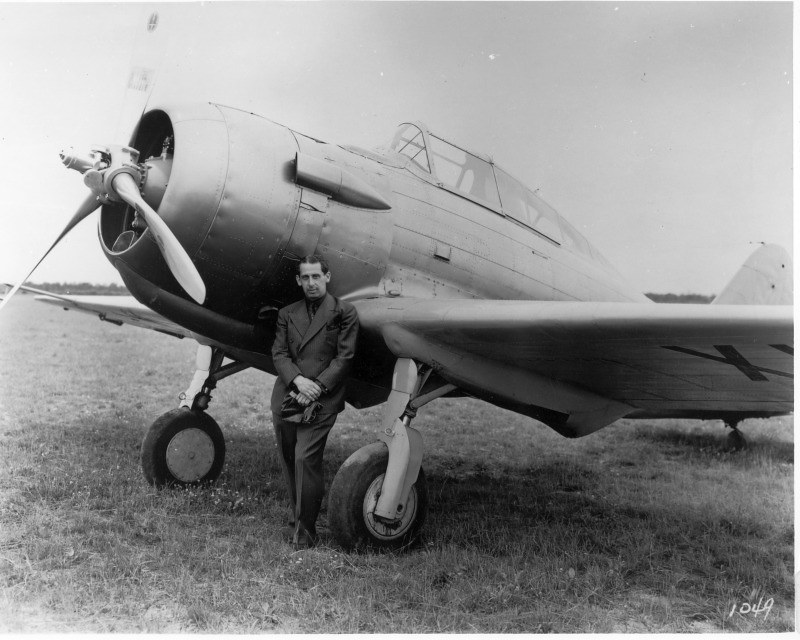
Seversky continued to experiment with new engines, installing a GR-1820G5. In January 1937, a change was made to the Pratt & Whitney Twin Wasp R-1830-13, the same engine being installed in production Curtiss-Wright P-36 Hawks. This was a two-row, supercharged 14-cylinder radial engine with a normal power rating of 900 horsepower at 2,550 r.p.m. to an altitude of 10,000 feet (3,048 meters), and 1,050 horsepower at 2,700 r.p.m. for takeoff. The airplane retained the same three-bladed constant-speed Hamilton Standard propeller which had been used with the Wright Cyclone engine. It was driven through a 3:2 gear reduction.
X18Y was reconfigured as a two-place civilian transport, with a small passenger cabin below and behind the cockpit. There were two fixed windows on the left side of the fuselage, and the passenger entered through a hatch on the right side, over the wing. A Pratt & Whitney Twin Wasp SB-G was fitted. This engine was very slight smaller and weighed less than the R-1830-13, and had a normal rating of 900 horsepower at 2,450 r.p.m. to 6,500 feet (1,981 meters), and 1,000 horsepower at 2,600 r.p.m. for takeoff.
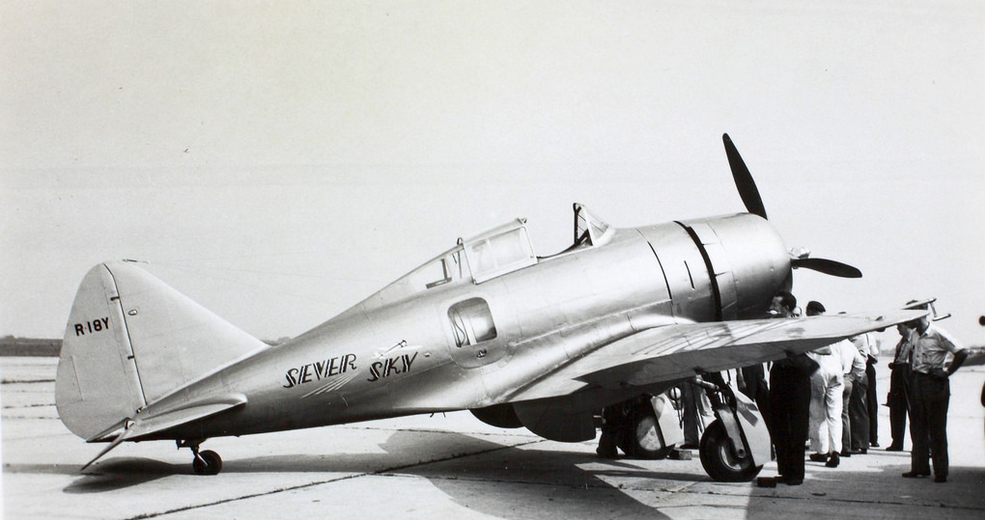
In this new configuration the SEV-1XP was called the “SEV-S1 Executive.” The experimental registration was changed to restricted: R18Y.
On 4 September 1937, R18Y was flown by Seversky’s chief test pilot, Frank Sinclair, in the cross-country Bendix Trophy Race. It carried the race number 63 on the vertical fin. Sinclair finished in fourth place, 33 minutes behind Jackie Cochran in her green Beechcraft D17W Staggerwing. He then flew R18Y in the Thompson Trophy pylon race, again finishing fourth with an average of 252.360 miles per hour (406.134 kilometers per hour).
On 27 October the SEV-1XP reverted to its experimental license number, X18Y.
Ms. Cochran continued to fly the Seversky in speed record attempts. On 3 December she flew it from Floyd Bennett Field in New York to Miami, Florida, in an elapsed time of 4:12:27.2, averaging 278.13 miles per hour (447.61 kilometers per hour).
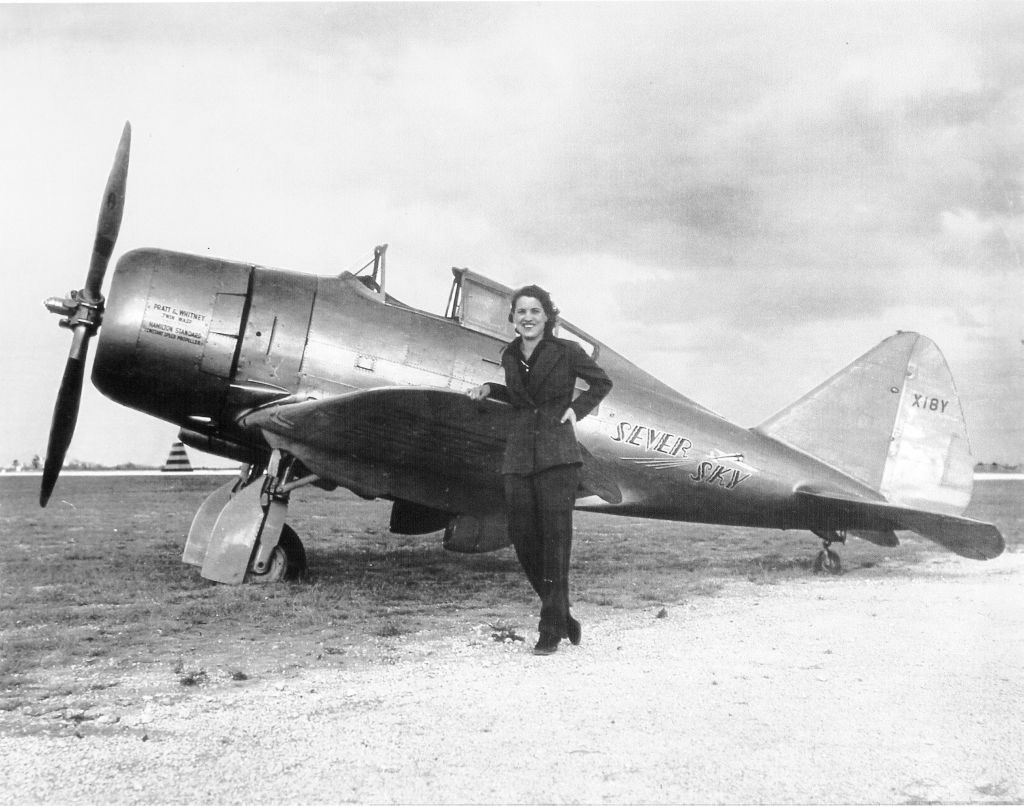
On 9 December Jackie flew X18Y to a new U.S. national record speed of 252.875 miles per hour (406.963 kilometers per hour) over a 100-kilometer course. She was attempting to increase the her speed on 13 December, reaching an average 255.973 miles per hour (411.949 kilometers per hour).
When she landed at Miami after the record runs, the Seversky’s tail wheel began rapidly swinging from side to side. This was something that the P-35s were experiencing and a number of the fighters had been wrecked. Jackie said, “One wing was pulled off altogether and the landing gear was torn off,” she said. “The tail [wheel] had jumped its lock throwing the plane to one side.”
The SEV-1XP was damaged beyond economical repair. In less than three years it had served its purpose. Seversky would build a new airplane. X18Y’s registration was suspended 4 January 1938 and the airplane was scrapped.
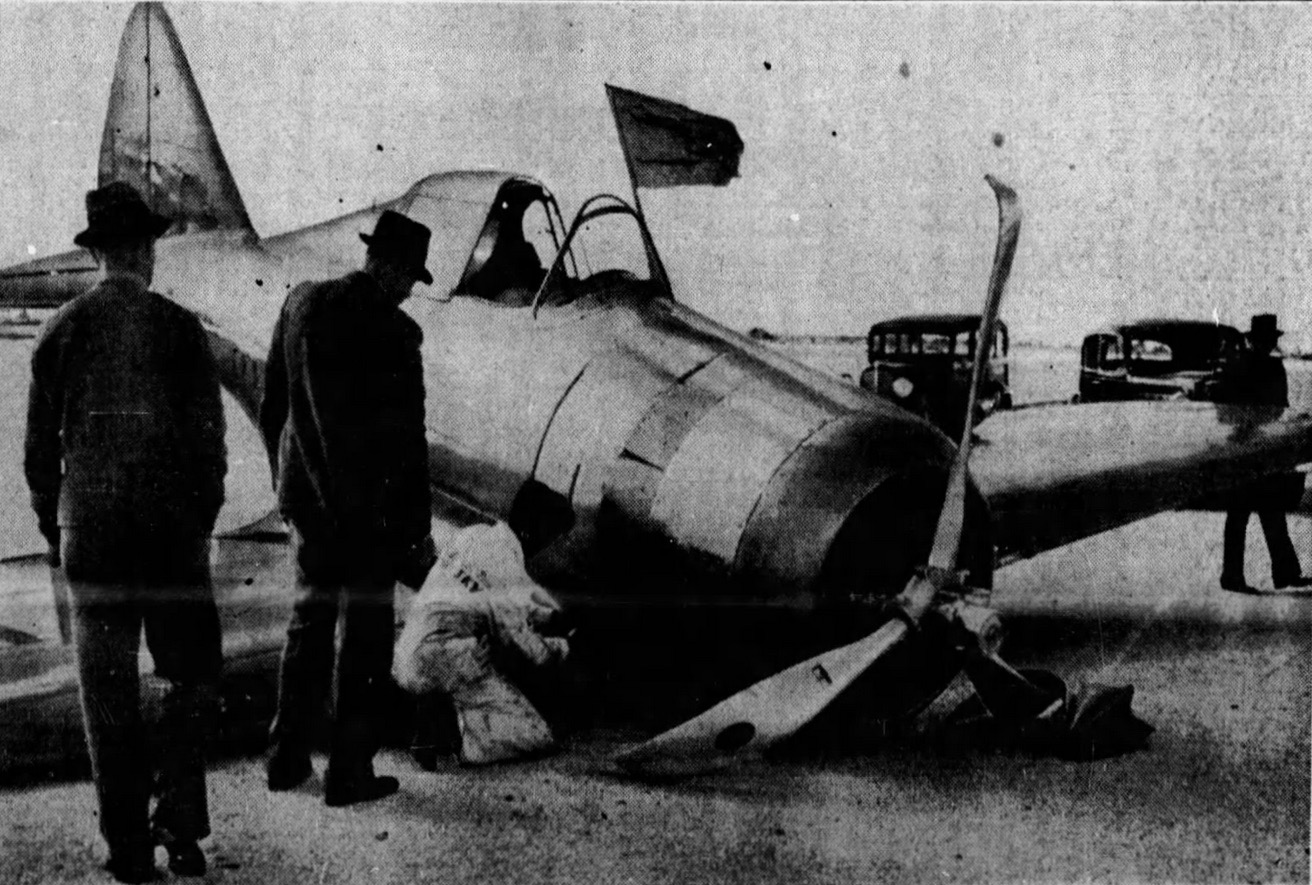
¹ FAI Record File Number 12026
© 2020, Bryan R. Swopes